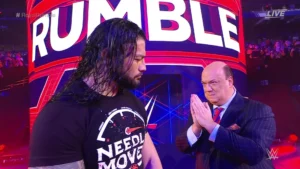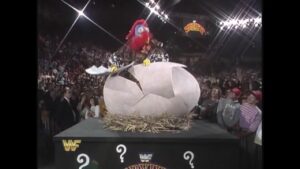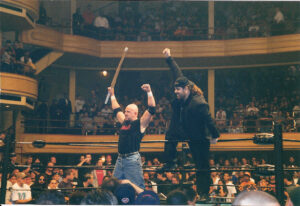Up until now, this series of columns on wrestling video games focused on home consoles. From the original Nintendo Entertainment System to the Nintendo 64, the systems we’ve covered were not considered portable. This wasn’t to say that options were nonexistent for gamers on the go. In fact, for at least one company in particular, handheld gaming has been a pillar of success. Let’s take a look at a sampling of the wrestling games to be released on the Game Boy family of systems.
The Game Boy Family
One of the terms most synonymous with Nintendo is “Game Boy.” Nintendo saw success with its series of Game and Watch devices, which ran through the 1980s up until the early 90s. However, these were designed with specific games in mind. If you picked up “Ball,” you could only play “Ball.” Starting with the Game Boy, which saw a 1989 release in Japan and North America, cartridge-based titles on handhelds became the norm.

Though technically limited, even during its release, the Game Boy was one of the most popular platforms in history. Its greenish screen and lack of backlight didn’t stop it from selling close to 120 million units. Much of this success can be attributed to the copious software released for the system. From “Tetris” to “The Legend of Zelda: Link’s Awakening” to the original “Pokemon” games, the Game Boy wasn’t short on content. Optional attachments, including a camera and printer, were released during its time. It can’t be denied that this platform enjoyed a long life.
During its time in the spotlight, the Game Boy saw other versions released, including the comparatively smaller Game Boy Pocket. The most notable upgrade, however, was the Game Boy Color, released in 1998. Though it shared numerous similarities to its predecessor, the Game Boy Color was regarded as its own system with a line of games it was compatible with. As the name implies, it also featured colors; 32,768 different ones, in fact. Additionally, its sizable memory made it a beefier upgrade to the original Game Boy.

The end of the line, however, came in the form of the Game Boy Advance. Released in 2001 in Japan and North America, the GBA could best be described as a Super Nintendo in a more compact form. It also implemented L and R buttons, which offered more variety, and the clamshell variant Game Boy Advance SP incorporated a backlight for easier viewing. Though the GBA offered many ports of older games, unique titles such as “Advance Wars” and the “WarioWare” series helped it stand out on its own.
When recalling the wrestling video games on the Game Boy family of consoles, challenges arose. These came down to the fact that while several wrestling titles made their way to these platforms, many of them ranged from unmemorable to disappointing. Whether it was due to a lack of understanding of the technology or time to refine the games, it’s difficult to recommend them over their home console contemporaries. With that said, there were a few standouts that the avid wrestling fan or gamer should give a look.

WWF Superstars
From “WWF RAW to “WWF Attitude,” the World Wrestling Federation had its fair share of titles released for the original Game Boy. As stated earlier, however, these titles are difficult to consider memorable. Though they tried valiantly to provide wrestling experiences to the handheld, they simply missed the mark. With that said, if there’s one Game Boy wrestling video game that deserves to have a spotlight shined on it, it would be this. “WWF Superstars” released in 1991 and was developed by Rare and published by Acclaim.
“WWF Superstars” holds the distinction of being the very first World Wrestling Federation game to hit the Game Boy. Therefore, it served as something of a template for other handheld titles to include. These included its followup, “WWF Superstars 2.” The fact that the “WWF Superstars” was the original is evident by its minimal roster. Hulk Hogan, Randy Savage, The Ultimate Warrior, Ted DiBiase, and Mr. Perfect were the only playable characters.
Despite the limitations of “WWF Superstars,” it was surprisingly ambitious for its time. The developers created a new engine for this title. It also featured pre-match promos and commentary, which provided a more dynamic presentation on the Game Boy’s small screen. “WWF Superstars” isn’t a title that one will sink hours upon hours into, but its importance in the history of wrestling video games shouldn’t be overlooked.

WWF Betrayal
The Game Boy Color was compatible with previous Game Boy games. As mentioned before, though, the former boasted its unique line of titles. Wrestling video games weren’t left out of the equation, which brings us to “WWF Betrayal.” Released in 2001, it was published by THQ and developed by WayForward. If the last name sounds familiar, it’s because WayForward would see success in other projects. These include the “Shantae” series, which began on the Game Boy Color as well.
“WWF Betrayal” was a departure from traditional wrestling games. First, it played like a side-scrolling beat ’em up, not unlike “Streets of Rage” or “Final Fight.” Second, it featured a unique story where the player would save a kidnapped Stephanie McMahon in exchange for a WWF Championship match. Throughout its highs and lows, “WWF Betrayal” featured a story that was different from its handheld counterparts.
Wrestling video games have developed a reputation for being difficult to simply pick up and play. “WWF Betrayal’s” style was straightforward and not overly complex. Keep in mind that the character was limited even for its time; outside of Steve Austin, The Rock, The Undertaker, and Triple H, there were no other licensed characters to play as. Furthermore, the game isn’t very long at all. In fact, don’t be surprised to see the end credits about a half-hour in. Despite its various hiccups, “WWF Betrayal” stands as an offshoot entry in a series of run-of-the-mill wrestling games.

Fire Pro Wrestling 2
Up until 2001, the “Fire Pro Wrestling” series didn’t see the light of day in Japan. “Fire Pro Wrestling” was niche among hardcore fans in the west. It wasn’t until Spike took over that titles began to spread outside of their home country. “Fire Pro Wrestling” for the Game Boy Advance was not only the first game in the series to make its way over to the states but the first to be released on a portable system. However, it wasn’t the only “Fire Pro Wrestling” title to come out for the GBA.
Enter “Fire Pro Wrestling 2,” which released in 2002 and was published by Spike and BAM Entertainment. As a direct sequel, “Fire Pro Wrestling 2” built upon the foundation set by its predecessor. This series was known for its timing-based gameplay. The fact it could be enjoyed on the go made it a more enticing prospect. Even fans that were unfamiliar with the series’ past picked up these titles. From there, they enjoyed the different look and feel compared to licensed wrestling offerings.
For those that are familiar with the series, “Fire Pro Wrestling 2” offered more of the same, but on the go. A wide array of maneuvers, a deep character creation suite, and various match types helped make it the most complete package of all wrestling video games on the Game Boy family of systems. Furthermore, there is currently a host of saves and mods for this little title. In short, the customization factor became that much more limitless.
In short, in a sea of wrestling video games on Nintendo’s Game Boy line, legitimately entertaining titles are limited. While the developers associated with these games aren’t incompetent, simply put, better options existed on other platforms. In fact, next time, we will shift our focus back to the home console side of gaming. Our next stop will be the PlayStation 2, which had a number of solid offerings.
Check out past entries from the “Revisiting Wrestling Video Games” series!
Stay tuned to the Last Word on Pro Wrestling for more on this and other stories from around the world of wrestling, as they develop. You can always count on LWOPW to be on top of the major news in the wrestling world, as well as to provide you with analysis, previews, videos, interviews, and editorials on the wrestling world.






